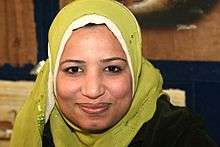Hijab by country
The word hijab refers to both the head-covering traditionally worn by some Muslim women and Islamic styles of dress in general.
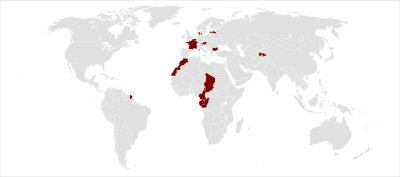
 |
| Part of a series on |
| Islamic female dress |
|---|
| Types |
| Practice and law by country |
| Concepts |
| Other |
The garment has different legal and cultural status in various countries. In the Indonesian Aceh province, Muslim women are required to wear the hijab[1] and all women are required to do so in Iran.[2]
France has banned overt religious symbols, including many religious headcoverings, in public schools and government buildings.[3] Kosovo (since 2009),[4] Azerbaijan (since 2010[5]), Tunisia (since 1981,[6] partially lifted in 2011) and Turkey (gradually lifted)[7][8] are the only Muslim-majority countries which have banned the hijab in public schools and universities or government buildings, while Syria and Egypt banned face veils in universities from July 2010 and 2015 respectively.[9][10] In other Muslim states such as Morocco,[11] there have been complaints of restriction or discrimination against women who wear the hijab. The hijab in these cases is seen as a sign of political Islam or fundamentalism against secular government.
Islamic dress, notably the variety of headdresses worn by Muslim women, has become a prominent symbol of the presence of Islam in western Europe. In several countries, this adherence to hijab has led to political controversies and proposals for a legal ban. Laws have been passed in France and Belgium to ban face-covering clothing, popularly described as the "burqa ban", although it does not only apply to the Afghan-model burqa.
Other countries are debating similar legislation, or have more limited prohibitions. Some of them apply only to face-covering clothing such as the burqa, boushiya, or niqāb, while other legislation pertains to any clothing with an Islamic religious symbolism such as the khimar, a type of headscarf. Some countries already have laws banning the wearing of masks in public, which can be applied to veils that conceal the face. The issue has different names in different countries, and "the veil" or hijab may be used as general terms for the debate, representing more than just the veil itself, or the concept of modesty embodied in hijab.
Although the Balkans and Eastern Europe have Muslim populations, most Muslims in western Europe are members of immigrant communities. The issue of Islamic dress is linked with issues of immigration and the position of Islam in Western Europe.
There are currently 16 nations that have banned the burqa (not to be confused with the hijab), including Tunisia,[12] Austria, Denmark, France, Belgium, Tajikistan, Latvia,[13] Bulgaria,[14] Cameroon, Chad, Congo-Brazzaville, Gabon, Netherlands,[15] China,[16] Morocco
Europe
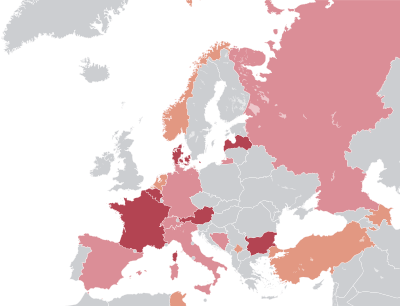
European Commissioner Franco Frattini said in November 2006, that he did not favour a ban on the burqa.[17] This is apparently the first official statement on the issue of prohibition of Islamic dress from the European Commission, the executive of the European Union.
Islamic dress is also seen as a symbol of the existence of parallel societies, and the failure of integration: in 2006, British Prime Minister Tony Blair described the face veil as a "mark of separation".[18] Proposals to ban hijab may be linked to other related cultural prohibitions, with Dutch politician Geert Wilders proposing a ban on hijab, on Islamic schools, the Quran, on new mosques, and on non-western immigration.
In France and Turkey, the emphasis is on the secular nature of the state, and the symbolic nature of the Islamic dress. In Turkey, bans previously applied at state institutions (courts, civil service) and in state-funded education, but were progressively lifted during the tenure of Recep Tayyip Erdoğan. In 2004, France passed a law banning "symbols or clothes through which students conspicuously display their religious affiliation" (including hijab) in public primary schools, middle schools, and secondary schools,[3] but this law does not concern universities (in French universities, applicable legislation grants students freedom of expression as long as public order is preserved[19]). These bans also cover Islamic headscarves, which in some other countries are seen as less controversial, although law court staff in the Netherlands are also forbidden to wear Islamic headscarves on grounds of 'state neutrality'.
An apparently less politicised argument is that in specific professions (teaching), a ban on "veils" (niqab) may be justified on the grounds that being able to see facial expressions and making eye contact can be helpful in communicating. This argument has featured prominently in judgments in Britain and the Netherlands, after students or teachers were banned from wearing face-covering clothing.
Public and political response to such prohibition proposals is complex, since by definition they mean that the government decides on individual clothing. Some non-Muslims, who would not be affected by a ban, see it as an issue of civil liberties, as a slippery slope leading to further restrictions on private life. A public opinion poll in London showed that 75 percent of Londoners support "the right of all persons to dress in accordance with their religious beliefs".[20] In another poll in the United Kingdom by Ipsos MORI, 61 percent agreed that "Muslim women are segregating themselves" by wearing a veil, yet 77 percent thought they should have the right to wear it.[21] In a later FT-Harris poll conducted in 2010 after the French ban on face-covering went into effect, an overwhelming majority in Italy, Spain, Germany and the UK supported passing such bans in their own countries.[22] The headscarf is perceived to be a symbol of the clash of civilizations by many. Others would also argue that the increase of laws surrounding the banning of headscarves and other religious paraphernalia has led to an increase in not just the sales of headscarves and niqabs, but an increase in the current religiosity of the Muslim population in Europe: as both a product of and a reaction to westernization.[23]
According to a ruling by the European Court of Justice in a case involving two Belgian women, employers in the EU may restrict the wearing of religious symbos if such regulations on appearance are applied in a consistent manner.[24]
Austria

In 2017, a legal ban on face-covering clothing was adopted by the Austrian parliament.[25][26] Headscarves were also banned in 2019 from primary schools.[27] In 2019, Austria banned the hijab in schools for children up to ten years of age. The ban was motivated by the equality between men and women and improving social integration with respect to local customs. Parents who send their child to school with a headscarf will be fined 440 euro.[28]
Belgium
As of 2015, Belgium has specific bans on face-covering dress, such as the niqab or burqa. On Tuesday 11 July 2017 the European Court of Human Rights upheld Belgium's ban on burqas and full-face veils.[29]
Bulgaria

In 2016, a ban on the wearing of face-covering clothing in public was adopted by the Bulgarian parliament.[30] The Bulgarian parliament enacted the ban on the basis of security concerns, however this stimulated conflict in the public as 10 percent of the country's population identifies as Muslim. Women who violate the burqa ban will face fines up to €770 (~US$848) and have their social security benefits suspended.[31]
Denmark
In autumn 2017, the Danish government considered adopting a law prohibiting people to wear "attire and clothing masking the face in such a way that it impairs recognizability".[32] The proposal was met with support from the three biggest political parties[33] and was passed into law on 31 May 2018, becoming § 134 c of the Danish Penal Code, stating that "[a]ny person who in a public place wears a item of clothing that covers said person's face shall be liable to a fine" with an exception for coverings that serve "a creditable purpose" (e.g. sports equipment, protection against the cold, masks for carnivals, masquerades etc.).[34][35] The law came into force on 1 August 2018. On the first day of the implementation of the burqa ban, hundreds of protesters rallied wearing face veils in public. According to the ban, wearing a burqa or a niqab in public can lead to a fine of 1000 kroner (~US$156) in case of first time offences, rising to 10,000 kr. (~US$1560) in case of the fourth offence.[36] [37] Under the ban, police are instructed to order women to remove their veils or to leave the public space. Police officers that fail to obey the orders of the ban are subject to be fined.
France
France is a secular country. One of the key principles of the 1905 French law on the Separation of the Churches and the State is the freedom of religious exercise. At the same time, this law prohibited public servants from wearing any religious signs during work.
In 1994, the French Ministry for Education sent out recommendations to teachers and headmasters to ban Islamic veil in educational institutions. According to a 2019 study by the Institute of Labor Economics, more girls with a Muslim background born after 1980 graduated from high school after the 1994 restrictions were introduced. While secularism is often criticized for restricting freedom of religion, the study suggested that "public schools ended up promoting the educational empowerment of some of the most disadvantaged groups of female students".[38]
In 2004, the French law on secularity and conspicuous religious symbols in schools banned most religious signs, including hijab, from public primary and secondary schools in France. The proposed ban was extremely controversial, with both sides of the political spectrum being split on the issue, some people arguing that the law goes against religious freedom and is racist because it affects mostly Muslim women and Jewish men.
In 2010, a ban on face covering,[39] targeting especially women wearing chador and burqa, was adopted by the French Parliament. According to the Guardian, the "Burqa ban", was challenged and taken to the European Court of Human Rights which upheld the law on 1 July 2014, accepting the argument of the French government that the law was based on "a certain idea of living together".[40] In 2013 "the applicant" stood outside Elysée Palace in niqab and subsequently received a criminal conviction. The French criminal courts noted in 2014 that the lower court was wrong to dismiss her rights covered under article 18 but dismissed her appeal.:16 The French delegation argued that wearing face coverings violated the principle of "living together". Judges Angelika Nussberger and Helena Jäderblom dissented, calling the concept, "far-fetched and vague.":61 Going on to note that the very decision of declaring what a woman is allowed to wear was hypocritical and antithetical to the aim of protecting human rights.[41] The committee came to the determination in 2018 that the case had been incorrectly dismissed after review by a single judge on the grounds that, "the conditions of admissibility laid down in articles 34 and 35 of the Convention [had] not been met." Upon review the committee concluded that the applicants's human rights had been violated under article 18 and 26 of the International Covenant on Civil and Political Rights.:13 The committee dismissed the notion of "living together" as a vague notion not protected under international law.[42]
A broader ban on hijab is regularly proposed by conservative and right-wing politicians.[43] Such a broader ban would include a ban in public universities but presidents of universities and most student unions oppose such a ban.[44]
Germany
In 2017, a ban on face-covering clothing for soldiers and state workers during work was approved by German parliament.[45]
Due to rapid demographic changes in Germany following immigration from Muslim countries, public debates ensued which among other topics concerned Islamic veils from the turn of the century onwards.[46]
In 2019 Susanne Schröter, an academic at Goethe University Frankfurt planned a conference titled "The Islamic veil – Symbol of dignity or oppression?" which led to a group of students protesting that value judgments on the veil should not be made. The protestors criticized the invitation of journalist Alice Schwarzer and publisher of feminist magazine EMMA. Schröter is a noted critic of Islamic veils and argues that the veil restricts a woman's freedom and usually comes with a bundle of restrictions. Schröter was backed by the president of Frankfurt University who stressed that it is her job to organize academic conferences where diverse opinions can be voiced. The president of the German Association of University Professors and Lecturers argued that freedom of speech meant that controversial topics should be resolved by debate, not "boycotts, mobbing or violence". Members of the Uni gegen antimuslimischen Rassismus (English: "University against anti-Muslim racism") boycotted the conference due to their objections regarding the invited participants.[46]
Ireland
In 2018, the prime minister Leo Varadkar ruled out a burka ban in Ireland, saying "I don’t like it but I think people are entitled to wear what they want to wear. […] I believe in the freedom of religion. I don’t agree with the doctrine of every religion or necessarily any religion, but I do believe in the freedom of religion."[47][48]
Kosovo

Since 2009, the hijab has been banned in public schools and universities or government buildings.[49] In 2014, the first female parliamentarian with hijab was elected to the Kosovo parliament.[50]
Latvia
In 2016 The Independent reported that a legal ban of face-covering Islamic clothing was adopted by the Latvian parliament.[13] After long public discussions draft legislation was approved by Latvian government on 22.08.2017, however it was never adopted by the parliament as a law.[51]
Malta
Malta has no restrictions on Islamic dressing such as the veil (hijab) nor the full face veil (burqa or niqab)[52] but lawfully face covering is illegal,[53] however an official ban on face covering for religious reasons is ambiguous.[54] However it is guaranteed that individuals are allowed to wear as they wish at their private homes and at the Mosque.[53] Imam El Sadi, from Mariam Al-Batool Mosque, has said that the banning of the niqab and the burka "offends Muslim women".[55] El Sadi said that the Maltese's "attitude towards Muslim women" is positive and despite cultural clashes their dressing is tolerated.[56] Some Muslim women share the belief that it is sinful to be seen in public without veiling themselves,[57][58] however they are lawfully required to remove it when needed – such as for photos on identifications.[59]
Netherlands
The Dutch government parliament in January 2012 enacted a ban on face-covering clothing, popularly described as the "burqa ban".[60][61] The burqa ban came into force on 1 August 2019 in schools, public transport, hospitals and government buildings, but there are doubts over whether it will be applied in practice.[62] Amsterdam's mayor, Femke Halsema, spoke out in her opposition of the law. Halsema stated that removing someone wearing a niqab in the Dutch capital would not be fitting with current Dutch society. Chairman of the Dutch Public Transport Association Pedro Peters also voiced his opinion on the ban. Peters said "You are not going to stop the bus for half an hour for someone wearing a burqa", and that "we are also not allowed to refuse anyone because we have a transport obligation".[63] Known officially as the Partial Ban on Face-Covering Clothing Act, the act also details that those who refuse to uncover their faces may pay a fine of at least 150 euros and can be arrested.[63] Dutch police have also stated that enforcing the ban is not a priority, and that they likely would not respond to a complaint within a thirty-minute timeframe.[64]
The Dutch government has also come under fire for the "burqa ban" from certain members of the UN claiming it is discriminatory towards Muslim women. On 7 October 2019 Tendayi Achiume, The United Nations Special Rapporteur on racism, wrote a report questioning the perceived inclusivity of Dutch society and how that perception masks a reality of treating racial and ethnic minorities as foreign. Speaking about the "burqa ban" Achiume said "The political debate surrounding the adoption of this law makes plain its intended targeting of Muslim women, and even if this targeting was not the intent, it has certainly been the effect".[65] In her report Achiume also reference a whistleblower in the Hague police department. She said that this whisleblower raised concerns about a culture of racism and targeted discrimination within the police department, and the government must act quickly to combat it.[66]
Norway
In 2018 the Norway parliament voted to ban the burqa in schools and universities.[67][68]
In April 2019, telecom company Telia received bomb threats after featuring a Muslim woman taking off her hijab in a commercial. Although the police did not evaluate the threat likely to be carried out, delivering threats is still a crime in Norway.[69][70]
Sweden
In December 2019, the municipality of Skurup banned Islamic veils in educational institutions. Earlier, the municipality of Staffanstorp approved a similar ban.[71]
Switzerland
In September 2013, a constitutional referendum in the Canton of Ticino on a popular initiative banning full-face veils was approved with 66,2 % of the vote.[72] In May 2017, the Landsgemeinde in the Canton of Glarus rejected adopting a similar measure with about two-thirds of the vote.[73] On the federal level, a popular initiative is still pending as of May 2020.
United Kingdom
The UK has no specific legislation prohibiting any form of traditional Islamic dress. In some cases, hijabs are worn by young girls from age 6–8.[74][75] According to retail chain Marks & Spencer, the hijabs they sell as part of the school uniform will fit a child aged 3.[76]
Muslim world
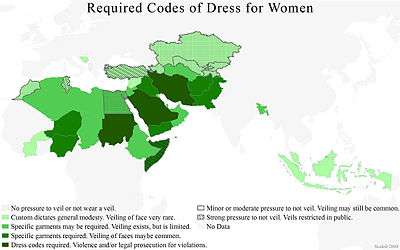
Algeria
In 2018, the government passed a law banning the wearing of full face-veils, called burqas or niqabs, for women at work.[77][78] The 2018 Prime Minister, Ahmed Ouahiya, pushed the ban because of his belief that women should be identifiable in the workspace.[79]
Afghanistan
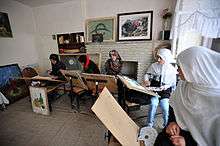
There is no legal hijab enforcement in Afghanistan, but it is predominantly worn largely due to cultural pressure. In the mid-20th century many women in urban areas did not wear head covering, but this ended with the outbreak of civil war in the 1990s.[80] The Afghan chadri is a regional style of burqa with a mesh covering the eyes.[81] It has been worn by Pashtun women since pre-Islamic times and was historically seen as a mark of respectability.[81] The burqa became a symbol of the conservative and totalitarian Taliban rule, who strictly enforced female adults to wear the dress. Although the Taliban regime ended in 2001, some women continue to wear it out of security concerns or as a cultural practice.[82][83][81] Opposers to the burqa claim it is not Islamic, nor part of Afghan culture.[84]
Egypt
In 1953, Egyptian leader President Gamal Abdel Nasser was told by the leader of the Muslim Brotherhood that they wanted to enforce the wearing of the hijab, to which Nasser responded: "Sir, I know you have a daughter in college – and she doesn't wear a headscarf or anything! Why don't you make her wear the headscarf? So you can't make one girl, your own daughter, wear it, and yet you want me to go and make ten million women wear it?".
The veil gradually disappeared in the following decades, so much so that by 1958 an article by the United Press (UP) stated that "the veil is unknown here."[85] However, the veil has been having a resurgence since the Iranian Revolution, concomitant with the global revival of Muslim piety. According to The New York Times, as of 2007 about 90 percent of Egyptian women currently wear a headscarf.[86]
Small numbers of women wear the niqab. The secular government does not encourage women to wear it, fearing it will present an Islamic extremist political opposition. In the country, it is negatively associated with Salafist political activism.[87][88] There has been some restrictions on wearing the hijab by the government, which views hijab as a political symbol. In 2002, two presenters were excluded from a state run TV station for deciding to wear hijab on national television.[89] The American University in Cairo, Cairo University and Helwan University attempted to forbid entry to niqab wearers in 2004 and 2007.[90][91][92]
Muhammad Sayyid Tantawy, Grand Imam of al-Azhar, issued a fatwa in October 2009 arguing that veiling of the face is not required under Islam. He had reportedly asked a student to take off her niqab when he spotted her in a classroom, and he told her that the niqab is a cultural tradition without Islamic importance.[87] It is widely believed that the hijab is becoming more of a fashion statement than a religious one in Egypt, with many Egyptian women, influenced by social peer pressure, wearing colorful, stylish head scarves along with western style clothing. Government bans on wearing the niqab on college campuses at the University of Cairo and during university exams in 2009 were overturned later.[93][94][95][96] Minister Hany Mahfouz Helal met protests by some human rights and Islamist groups.
In 2010, Baher Ibrahim of The Guardian criticized the increasing trend for pre-pubescent girls in Egypt to wear the hijab.[97]
Many Egyptians in the elite are opposed to hijab, believing it harms secularism. By 2012 some businesses had established bans on veils, and Egyptian elites supported these bans.[98]
Indonesia

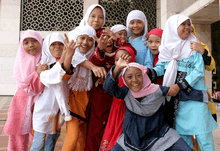
In Indonesia, the term jilbab is used without exception to refer to the hijab.[99] Under Indonesian national and regional law, female head-covering is entirely optional and not obligatory.
In 2008, Indonesia had the single largest global population of Muslims. However, the Indonesian Constitution of Pancasila provides equal government protection for six state-sanctioned religions (namely Islam, Catholicism, Protestantism, Buddhism, Hinduism and Confucianism), without any one supreme or official state religion.
Some women may choose to wear a headscarf to be more "formal" or "religious", such as the jilbab or kerudung (a native tailored veil with a small, stiff visor). Such formal or cultural Muslim events may include official governmental events, funerals, circumcision (sunatan) ceremonies or weddings. However, wearing Islamic attire to Christian relatives' funerals and weddings and entering the church is quite uncommon.
Culturally to the Javanese majority, plain, Saudi-style hijab, the niqab or socially worse yet the indigenous peasant kerudung (known in North Sumatran languages as tudung) is considered vulgar, low-class and a faux pas – the traditional Javanese hijab are transparent, sheer, intricately brocaded or embroidered fine silk or lace tailored to match either their sarung or kebaya blouse.
Young girls may also elect to wear the hijab publicly to avoid unwanted low-class male attention and molestation and thus display their respectability as "good Muslim girls": that is, they are not "easy" conquests.[100] Additionally, Islamic private school uniform code dictate that female students must wear the jilbab (commonly white or blue-grey, Indonesia's national secondary school colours), in addition to long-sleeved blouse and ankle-length skirt. Islamic schools must by law provide access to Christians (and vice versa Catholic and Protestant schools allow Muslim students) and it is to be worn by Christian students who attend Muslim school, and its use by Muslim students is not objected to in Christian schools.
Many nuns refer to their habit as a jilbab, perhaps out of the colloquial use of the term to refer to any religious head covering.
The sole exception where jilbab is mandatory is in Aceh Province, under Islamic Sharia-based Law No 18/2001, granting Aceh special autonomy and through its own Regional Legislative body Regulation Nr. 5/2001, as enacted per Acehnese plebiscite (in favour). This Acehnese Hukum Syariah and the reputedly over-bearing "Morality Police" who enforce its (Aceh-only) mandatory public wearing are the subject of fierce debate, especially with regard to its validity vis-a-vis the Constitution among Acehnese male and female Muslim academics, Acehnese male and female politicians and female rights advocates.
Female police officers are not allowed to wear hijab, except in Aceh. But since 25 March 2015, based on Surat Keputusan Kapolri Nomor:Kep/245/II/2015 female police officers can now wear hijab if they want. Flight attendants are not allowed to wear hijab except during flights to the Middle East.
Compounding the friction and often anger toward baju Arab (Arab clothes), is the ongoing physical and emotional abuse of Indonesian women in Saudi Arabia, as guest workers, commonly maids or as Hajja pilgrims and Saudi Wahhabi intolerance for non-Saudi dress code has given rise to mass protests and fierce Indonesian debate up to the highest levels of government about boycotting Saudi Arabia – especially the profitable all Hajj pilgrimage – as many high-status women have been physically assaulted by Saudi morality police for non-conforming head-wear or even applying lip-balm – leading some to comment on the post-pan Arabist repressiveness of certain Arab nations due to excessively rigid, narrow and erroneous interpretation of Sharia law.[101][102]
Iran
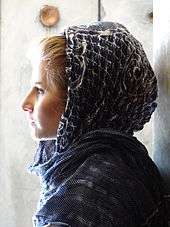
.jpg)

In Iran, since the 1979 Islamic Revolution, the hijab has become compulsory. Women are required to wear loose-fitting clothing and a headscarf in public.[103][104]
This partially changed in the Middle Ages after the arrival of the Turkic nomadic tribes from Central Asia, whose women didn't wear headscarves.[105][106] However, after the Safavid centralization in the 16th century, the headscarf became defined as the standard head dress for women in urban areas all around the Iranian Empire.[107] Exceptions to this were seen only in the villages and among nomadic tribes,[105][106][108][109][110] such as Qashqai. Covering the whole face was rare among the Iranians and was mostly restricted to local Arabs and local Afghans. Later, during the economic crisis in the late 19th century under the Qajar dynasty, the poorest urban women could not afford headscarves.[108][111] In the early 20th century, Iranians associated not covering the hair as something rural, nomadic, poor and non-Iranian.
On 8 January 1936,[112] Reza Shah issued a decree, banning all veils.[113][104][114][115][116] Many types of traditional men’s clothing was also banned, in order that "westerners shouldn’t laugh." The ban humiliated and alienated many Iranian women.[117][118][119][120]To enforce this decree, police were ordered to physically remove the veil off of any woman who wore it in public. Women were beaten, their headscarves and chadors torn off, and their homes forcibly searched.[120][104][114][121][122] Until Reza Shah's abdication in 1941, many women simply chose not leave their houses in order to avoid such embarrassing confrontations, and some even committed suicide.[113][109][117][118][119]
Official measures were relaxed under Reza Shah's successor, Mohammad Reza Pahlavi, and the wearing of a headscarf or chador was no longer an offence, but was still considered an indicator of backwardness or of membership of the lower class.[120] Discrimination against women wearing the headscarf or chador was still widespread with public institutions actively discouraging their use, and some eating establishments refusing to admit women who wore them.[113][123]
In the aftermath of the revolution, hijab was made compulsory in stages.[104] In 1979, Ayatollah Khomeini announced that women should observe Islamic dress code, his statement sparked demonstrations which were met by government assurances that the statement was only a recommendation.[104][124] Hijab was subsequently made mandatory in government and public offices in 1980, and in 1983 it became mandatory for all women (including non-Muslims and non-citizens).[104]
White Wednesday
In May 2017, My Stealthy Freedom, an Iranian online movement advocating for women's freedom of choice, created the White Wednesday movement: a campaign that invites men and women to wear white veils, scarves or bracelets to show their opposition to the mandatory forced veiling code.[125] The movement was geared towards women who proudly wear their veils, but reject the idea that all women in Iran should be subject to forced veiling.[126] Masih Alinejad, an Iranian-born journalist and activist based in the United Kingdom and the United States, created the movement to protest Iran's mandatory hijab rule.[127] She described her 2017 movement via Facebook, saying, "This campaign is addressed to women who willingly wear the veil, but who remain opposed to the idea of imposing it on others. Many veiled women in Iran also find the compulsory imposition of the veil to be an insult. By taking videos of themselves wearing white, these women can also show their disagreement with compulsion."[127] The campaign resulted in Iranian women posting pictures and videos of themselves wearing pieces of white clothing to social media.[125]
The Girls of Enghelab Street
On 27 December 2017, 31-year-old Vida Movahed, also known as "The Girl of Enghelab Street" was arrested for being unveiled in public after a video of the woman went viral on social media.[128][129] The video showed Movahed silently waving her hijab, a white headscarf that she had removed from her head and placed on a stick for one hour on Enqelab Street, Tehran.[130][128] At first it was assumed that her act was connected to the widespread protests taking place in Iran, but Movahed confirmed that she performed the act in support of the 2017 White Wednesday campaign.[131] Vida's arrest sparked outrage from social media, where many Iranians shared footage of her protest along with the hashtag "#Where_Is_She?". On 28 January 2018, Nasrin Sotoudeh, a renowned human rights lawyer, posted on Facebook that Vida had been released.[132] It was not until a few weeks later that Sotoudeh revealed the girl's identity.[133] In the following weeks, multiple people re-enacted Vida Movahed|Vida's]] public display of removing their hijabs and waving them in the air.[128] On 1 February 2018, the Iranian police released a statement saying that they had arrested 29 people, mostly women, for removing their headscarves, contrary to Iranian law.[128][134] One woman, Shima Babaei, was arrested after removing her headdress in front of a court as a symbol of her continued dedication to the cause.
On 23 February 2018, Iranian Police released an official statement saying that any women found protesting Iran's compulsory veiling code would be charged with "inciting corruption and prostitution," which carries a maximum sentence of 10 years in prison.[135] Before this change, according to article 638 of the Islamic Penal Code of the Islamic Republic of Iran, "Anyone in public places and roads who openly commits a harām (sinful) act, in addition to the punishment provided for the act, shall be sentenced to two months imprisonment or up to 74 lashes; and if they commit an act that is not punishable but violates public prudency, they shall only be sentenced to ten days to two months' imprisonment or up to 74 lashes. Note- Women who appear in public places and roads without wearing an Islamic hijab, shall be sentenced to ten days to two months' imprisonment or a fine of fifty thousand to five hundred rials."[136][136]
Following the announcement, multiple women reported being subjected to physical abuse by police following their arrests.[135] Some have since been sentenced to multiple years in prison for their acts of defiance.[137] In one video, a woman stands on top of a tall box, unveiled, waving her white scarf at passers by. The video then shows a man in a police uniform tackling the woman to the ground.[138] Shortly after the video went viral, the Ministry of Interior (Iran) scolded police for using physical force against the woman. Salman Samani, a spokesman for Ministry released a statement on 25 February 2018 saying "No one has a license to act against the law even in the role of an officer dealing with crimes."[138]
On 8 March 2018, a video of three Iranian women singing a feminist fight song in Tehran's subway went viral on.[139] The women were singing in honor of International Women's Day and to highlight women's continued challenges caused by forced veiling and other discriminatory laws against women.[139] In the video, in which three bare-headed Iranian women sing I am a Woman, calls upon women to join efforts to fight injustice and create "another world" of "equality". The women hold hands, display pictures of a previous women's rights protest, and ask the other women on the subway train to clap in honor of "having lived and fought all their lives against all kinds of discrimination, violence, humiliation, and insults." At the end of the video, one of the protestors is heard saying "Happy Women's Day to all of you."[139]
That same day, the Supreme Leader of Iran, Ali Khamenei, made a speech during a gathering of religious poets in Tehran, posting a series of tweets in response to the series of peaceful hijab protests.[140] Khamenei defended the dress code, praising Islam for keeping women "modest" and in their "defined roles" such as educators and mothers. He also lashed out at the Western World for, in his view, leading its own women astray.[141] "The features of today’s Iranian woman include modesty, chastity, eminence, protecting herself from abuse by men," Khamenei tweeted. He claimed that the most sought after characteristic of a Western woman involve is her ability to physically attract men.[142]
Iraq
.jpg)
In south Iraq, particularly in the Shi'a holy cities of Najaf and Karbala, custom requires women to wear hijab. Women in public places usually wear abaya which is a long black cloth that covers the whole body except the face and the hands, in addition to the scarf that only covers the hair. They might wear boushiya. In private, in governmental institutions and universities they can wear manteaux which could be long or short with a scarf covering the head.In Arab Sunni majority provinceses of East Iraq hijab/heads is also mandatory. In Baghdad and Iraqi Kurdistan, women are free to choose whether or not to wear the hijab.
In 2017, the Iraqi army imposed a burqa ban in the liberated areas of Mosul for the month of Ramadan. Police stated that the temporary ban was for security measures, so that ISIS bombers could not disguise themselves as women.[143]
Jordan
There are no laws requiring the wearing of headscarves nor any banning such from any public institution. The use of the headscarf increased during the 1980s. However, the use of the headscarf is generally prevalent among the lower and lower middle classes. Veils covering the face as well as the chador are rare. It is widely believed that the hijab is increasingly becoming more of a fashion statement in Jordan than a religious one with Jordanian women wearing colorful, stylish headscarves along with western-style clothing.[144]
Lebanon
Hijab is not regulated by law in Lebanon.
Malaysia

The headscarf is known as a tudung, which simply means "cover". (The word is used with that meaning in other contexts, e.g. tudung saji, a dish cover for food.) Muslim women may freely choose whether or not to wear the headscarf. The exception is when visiting a mosque, where the tudung must be worn; this requirement also includes non-Muslims.
Although headscarves are permitted in government institutions, public servants are prohibited from wearing the full-facial veil or niqab. A judgment from the then–Supreme Court of Malaysia in 1994 cites that the niqab, or purdah, "has nothing to do with (a woman's) constitutional right to profess and practise her Muslim religion", because Islam does not make it obligatory to cover the face.[145]
Although wearing the hijab, or tudung, is not mandatory for women in Malaysia, some government buildings enforce within their premises a dress code which bans women, Muslim and non-Muslim, from entering while wearing "revealing clothes".[146][147]
As of 2013 the vast majority of Muslim Malaysian (mostly ethnic Malay) women wear the tudung, a type of hijab. This use of the tudung was uncommon prior to the 1979 Iranian revolution,[148] and the places that had women in tudung tended to be rural areas. The usage of the tudung sharply increased after the 1970s,[147] as religious conservatism among Malay people in both Malaysia and Singapore increased.[149]
Several members of the Kelantan ulama in the 1960s believed the hijab was not mandatory.[148] By 2015 the Malaysian ulama believed this previous 'fatwa' was un-Islamic.[150]
By 2015 Malaysia had a fashion industry related to the tudung.[148]
Maldives
There are no official laws in the Constitution of the Maldives that require women to cover their heads, but Maldivian women commonly wear a hijab and niqab in public. There are reports of women being pressured into covering themselves by close relatives;[151] conversely, the American U.S. State Department's annual International Religious Freedom Report in 2007 referenced one instance in which a female student was restricted from attending school for wearing a headscarf, despite civil servants wearing them at work without issue.[152][153]
Morocco
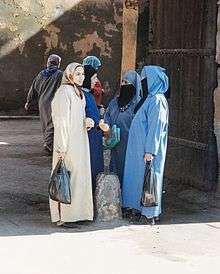
In Morocco, the headscarf is not forbidden by law, and women are free to choose to wear one. The headscarf is more frequent in the northern regions, small to medium cities and rural regions. As it is not totally widespread, wearing a hijab is considered rather a religious decision. In 2005, a schoolbook for basic religious education was heavily criticized for picturing female children with headscarves, and later the picture of the little girl with the Islamic headscarf was removed from the school books.[154] The headscarf is strongly and implicitly forbidden in Morocco's military and the police.
In January 2017 Morocco banned the manufacturing, marketing and sale of the burqa.[155]
Pakistan
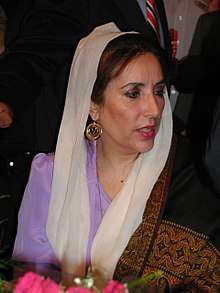
Pakistan has no laws banning or enforcing the ħijāb.
In Pakistan, most women wear shalwar kameez, a tunic top and baggy or skintight trouser set which covers their legs and body. Depending on the societal status and city, a loose dupatta scarf is worn around the shoulders and upper chest or just on the shoulder, or isn't used at all. Women are not expected to wear a hijab or scarf in public,[156][157] but many women in Pakistan wear different forms of the ħijāb and it varies for rural and different urban areas. For example, in the Khyber Pakhtunkhwa province and the Federally Administered Tribal Areas a minority of the women wear the full head-to-toe black burqa/chador while in the rest of the provinces, including Azad Kashmir, most of the women wear the dupatta (a long scarf that matches the woman's garments).
In Karachi, middle-class women wore black 2-piece burqas, sometimes with a 3rd piece of a sheer face veil, in the 1950s in public. Starting in the 1960s, the 3 piece suit of shalvar, kameez, and dupatta over the shoulders, and uncovered head and hair, gradually became more popular. Many women who immigrated to Pakistan from India wore midriff bearing saris. In the late '90s the trend began to reverse, when more women began wearing the black burqa, or otherwise covering their head with a dupatta or scarf. There are two primary reasons for the reversal: many Pakistanis have lived in Persian Gulf countries and became accustomed to hijab and black abayas; there has been more gun violence in Pakistani society since the 1980s due to the trafficking of arms to Afghanistan, and some women feel safer being covered up. Today only the most fashionable women wear saris. Neighboring Iran, where women wear pants with an overcoat and scarf, is closer to what Pakistani women wear and there is some cross-influence.
Westerners are also expected to dress modestly. Pakistani society observes traditional dress customs and it is advisable for women to wear long trousers which cover all of the legs, and tops with sleeves which don't show cleavage. Baring a midriff in a sari is more accepted than baring legs of any length. In the big cities, some teenage girls wear jeans underneath tunics, especially in casual settings, shopping malls and around picnic spots. Dress codes for men are more lax, though shorts, t-shirts, vest tops, and speedos are uncommon. For women, swimsuits and midi-and mini-skirts are considered immodest and are thus a social taboo.[156][157]
Saudi Arabia
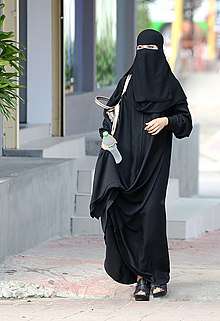
While most versions of Islamic law suggests that women should dress modestly, Saudi Arabian dress code used to legally require women, local and foreign, to wear an abaya, a garment that covers the body and arms in public.[158][159] According to most Salafi scholars, a woman is to cover her entire body, including her face and hands, in front of unrelated men. Hence, the vast majority of traditional Saudi women are expected to cover their body and hair in public.[160][161][162][163][164]
The Saudi niqāb usually leaves a long open slot for the eyes; the slot is held together by a string or narrow strip of cloth.[165]
The Saudi burqa is a typically black garment that completely covers a woman head to toe, including a veil that covers her face, with a mesh window across the eyes to see out of.[166][167]
It is widely believed that the abaya is increasingly becoming more of a fashion statement in Saudi Arabia than a religious one with Saudi women wearing colorful, stylish Abayas along with western-style clothing.[168]
Women in Saudi Arabia need not wear headcover or the black abaya – the loose-fitting, full-length robes symbolic of Islamic piety – as long as their attire is "decent and respectful", the kingdom's reform-minded crown prince said.[169]
Somalia
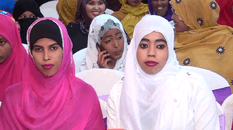
During regular, day-to-day activities, Somali women usually wear the guntiino, a long stretch of cloth tied over the shoulder and draped around the waist. In more formal settings such as weddings or religious celebrations like Eid, women wear the dirac, which is a long, light, diaphanous voile dress made of cotton or polyester that is worn over a full-length half-slip and a brassiere. Married women tend to sport head-scarves referred to as shash, and also often cover their upper body with a shawl known as garbasaar. Unmarried or young women, however, They wear hijab, and the jiilbab is also commonly worn.[170]
Sudan
While the hijab is not explicitly mandated by law, Sudanese women are required to dress modestly in public. Due to Sudan's vaguely worded Public Order law, there are no delineated parameters of what constitutes immodest dress. The law states: "Whoever does in a public place an indecent act or an act contrary to public morals or wears an obscene outfit or contrary to public morals or causing an annoyance to public feelings shall be punished with flogging which may not exceed forty lashes or with fine or with both".[171] In 2013, the case of Amira Osman Hamid came to international attention when she chose to expose her hair in public, in opposition to the nation's public-order laws.[172]
Syria
In 2010, Ghiyath Barakat, Syria's minister of higher education, announced a ban on women wearing full-face veils at universities. The official stated that the face veils ran counter to secular and academic principles of Syria.[173] However, the ban strictly addresses veils that cover the head and mouth, and does not include hijabs, or headscarfs, which most Syrian women wear.[174]
Tajikistan
.jpg)
In 2017 the government of Tajikistan passed a law requiring people to "stick to traditional national clothes and culture", which has been widely seen as an attempt to prevent women from wearing Islamic clothing, in particular the style of headscarf wrapped under the chin, in contrast to the traditional Tajik headscarf tied behind the head.[175]
Tunisia
Tunisian authorities say they are encouraging women, instead, to "wear modest dress in line with Tunisian traditions", i.e. no headscarf. In 1981, women with headscarves were banned from schools and government buildings, and since then those who insist on wearing them face losing their jobs.[6] Recently in 2006, the authorities launched a campaign against the hijab, banning it in some public places, where police would stop women on the streets and ask them to remove it, and warn them not to wear it again. The government described the headscarf as a sectarian form of dress which came uninvited to the country.[176]
As of 14 January 2011, after the Tunisian revolution took place,[177] the headscarf was authorized and the ban lifted. However, in contemporary urban Tunisian society, remnants of decades worth of discouragement remain.
On 6 July 2019 the government banned the wearing of the niqab in public institutions citing security reasons.[178]
Turkey
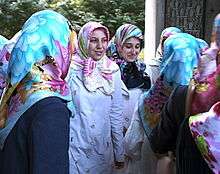
Turkey is officially a secular state, and the hijab was banned in universities and public buildings until late 2013 – this included libraries or government buildings. The ban was first in place during the 1980 military coup, but the law was strengthened in 1997. There has been some unofficial relaxation of the ban under governments led by the conservative party AKP in recent years,[88] for example the current government of the AKP is willing to lift the ban in universities, however the new law was upheld by the constitutional court.
Some researchers claim that about 55–60% of Turkish women cover their heads. A number of women wear a headscarf for cultural reasons. That cultural headscarf is used by women that work under the sun to protect their heads from sunburn.[179] In cities like Istanbul and Ankara about a half of women cover their heads.[180] In the cities in eastern Turkey, more women cover their heads .[181][182][183]
On 7 February 2008, the Turkish Parliament passed an amendment to the constitution, allowing women to wear the headscarf in Turkish universities, arguing that many women would not seek an education if they could not wear the hijab.[184][185][186][184] The decision was met with powerful opposition and protests from secularists. On 5 June 2008, the Constitutional Court of Turkey reinstated the ban on constitutional grounds of the secularity of the state.[187] Headscarves had become a focal point of the conflict between the ruling Justice and Development Party (AKP) and the secularist establishment. The ruling was widely seen as a victory for Turks who claim this maintains Turkey's separation of state and religion. In 2013, the headscarf ban in public institutions was lifted through a decree, even though the ban officially stands through court decisions.[188] The ban on wearing hijab in high schools was lifted in 2014.[8]
Yemen
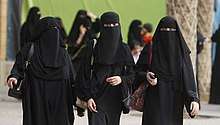
Although there is no dress code that legally forces veiling upon women in Yemen, the abaya and niqab are social norms in Yemen and are worn by girls from a young age. In some areas, the hijab is part of school uniforms. Yemeni women who choose to not wear headscarves are at risk of oppression.[189]
When Nobel Peace Laureate Tawakkol Karman was asked by journalists about her hijab with regard to her intellect and education, she replied, "man in early times was almost naked, and as his intellect evolved he started wearing clothes. What I am today and what I’m wearing represents the highest level of thought and civilization that man has achieved, and is not regressive. It’s the removal of clothes again that is regressive back to ancient times."[190]
Israel
In July 2010, some Israeli lawmakers and women's rights activists proposed a bill to the Knesset banning face-covering veils. According to the Jerusalem Post, the measure is generally "regarded as highly unlikely to become law." Hanna Kehat, founder of the Jewish women's rights group Kolech, criticized a ban and also commented "[f]ashion also often oppresses women with norms which lead to anorexia." Eilat Maoz, general coordinator for the Coalition of Women for Peace, referred to a ban as "a joke" that would constitute "racism".[191] In Israel, orthodox Jews dress modestly by keeping most of their skin covered. Married women cover their hair, most commonly in the form of a scarf, also in the form of hats, snoods, berets, or, sometimes, wigs.[192][193]
Gaza Strip

Successful informal coercion of women by sectors of society to wear Islamic dress or hijab has been reported in the Gaza Strip where Mujama' al-Islami, the predecessor of Hamas, reportedly used a mixture of consent and coercion to "'restore' hijab" on urban-educated women in Gaza in the late 1970s and 1980s.[194] Similar behavior was displayed by Hamas during the First Intifada.[195] Hamas campaigned for the wearing of the hijab alongside other measures, including insisting that women stay at home, they should be segregated from men, and for the promotion of polygamy. During the course of this campaign women who chose not to wear the hijab were verbally and physically harassed, with the result that the hijab was being worn "just to avoid problems on the streets".[196]
Following the takeover of the Gaza Strip in June 2007, Hamas has attempted to implement Islamic law in the Gaza Strip, mainly at schools, institutions and courts by imposing the Islamic dress or hijab on women.[197]
Some of the Islamization efforts met resistance. When Palestinian Supreme Court Justice Abdel Raouf Al-Halabi ordered women lawyers to wear headscarves and caftans in court, attorneys contacted satellite television stations including Al-Arabiya to protest, causing Hamas's Justice Ministry to cancel the directive.[198]
In 2007, the Islamic group Swords of Truth threatened to behead female TV broadcasters if they didn't wear the hijab. "We will cut throats, and from vein to vein, if needed to protect the spirit and moral of this nation," their statement said. The group also accused the women broadcasters of being "without any ... shame or morals". Personal threats against female broadcasters were also sent to the women's mobile phones, though it was not clear if these threats were from the same group. Gazan anchorwomen interviewed by Associated Press said that they were frightened by the Swords of Truth statement.[199]
In February 2011, Hamas banned the styling of women's hair, continuing its policy of enforcing Sharia upon women's clothing.[200]
Hamas has imposed analogous restrictions on men as well as women. For example, men are no longer allowed to be shirtless in public.[200]
Northern Cyprus
Muslim Turkish-Cypriot women wore traditional Islamic headscarves.[201] When leaving their homes, Muslim Cypriot women would cover their faces by pulling a corner of the headscarf across their nose and mouth, a custom recorded as early as 1769.[202]
Their head dress...consists of a collection of various handkerchiefs of muslim, prettily shaped, so that they form a kind of casque of a palm's height, with a pendant behind to the end of which they attach another handkerchief folded in a triangle, and allowed to hang on their shoulders. When they go out of doors modesty requires that they should take a corner and pull it in front to cover the chin, mouth and nose. The greater part of the hair remains under the ornaments mentioned above, except on the forehead where it is divided into two locks, which are led along the temples to the ears, and the ends are allowed to hang loose behind over the shoulders.
— Giovanni Mariti, Travels in the Island of Cyprus, 1769
In accordance with the islands' strict moral code, Turkish Cypriot women also wore long skirts or pantaloons in order to cover the soles of their feet. Most men covered their heads with either a headscarf (similar to a wrapped keffiyeh, "a form of turban"[203]) or a fez. Turbans have been worn by Cypriot men since ancient times and were recorded by Herodotus, during the Persian rule of the island, to demonstrate their "oriental" customs compared to Greeks.[204]
Following the globalisation of the island, however, many younger Sunni Muslim Turkish-Cypriots abandoned wearing traditional dress, such as headscarves.[205] Yet they are still worn by older Muslim Cypriot women.
Until the removal of ban on headscarf in universities in Turkey in 2008,[206] women from Turkey moved to study in Northern Cyprus since many universities there did not apply any ban on headscarf.[207] Whilst many Turkish Cypriot women no longer wear headscarves, recent immigrants from Turkey, settled in villages in northern Cyprus, do.[208]
Former Soviet Central Asia
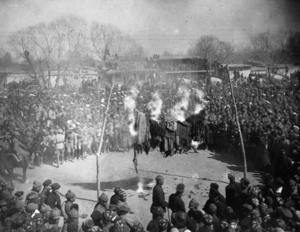
The word "hijab" was used only for the middle-eastern style of hijab, and such style of hijab was not commonly worn by Muslims there until the fall of the Soviet Union. Some Islamic adherents (like Uzbeks) used to wear the paranja, while others (Chechens, Kara-Chai, Tajiks, Kazakhs, Turkmens, etc.) wore traditional scarves the same way as a bandanna and have own traditional styles of headgear which are not called by the word hijab.
Africa

Cameroon
On 12 July 2015, two women dressed in religious garments blew themselves up in Fotokol, killing 13 people. Following the attacks, since 16 July, Cameroon banned the wearing of full-face veils, including the burqa, in the Far North region. Governor Midjiyawa Bakari of the mainly Muslim region said the measure was to prevent further attacks.[209]
Chad
Following a double suicide bombing on 15 June 2015 which killed 33 people in N'Djamena, the Chadian government announced on 17 June 2015 the banning of the wearing of the burqa in its territory for security reasons.[210] The 2015 Prime Minister, Kalzeube Pahimi Deubet, called the burqa "camouflage."[211] Women who violate this ban are subject to jail time.[212]
Congo-Brazzaville
The full-face veil was banned in May 2015 in public places in Congo-Brazzaville to "counter terrorism", although there has not been an Islamist attack in the country.[209]
Asia-Pacific
Australia
In September 2011, Australia's most populous state, New South Wales, passed the Identification Legislation Amendment Act 2011 to require a person to remove a face covering if asked by a state official. The law is viewed as a response to a court case of 2011 where a woman in Sydney was convicted of falsely claiming that a traffic policeman had tried to remove her niqab.[213]
The debate in Australia is more about when and where face coverings may legitimately be restricted.[214] In a Western Australian case in July 2010, a woman sought to give evidence in court wearing a niqab. The request was refused on the basis that the jury needs to see the face of the person giving evidence.[214]
China
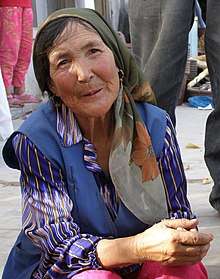
In 2017, China banned the burqa in the Islamic area of Xinjiang.[215]
Myanmar
At a conference in Yangon held by the Organization for the Protection of Race and Religion on 21 June 2015, a group of monks locally called Ma Ba Tha declared that the headscarves "were not in line with school discipline", recommending the Burmese government to ban the wearing of hijabs by Muslim schoolgirls and to ban the butchering of animals on the Eid holiday.[216]
Sri Lanka
A Sri Lankan MP called for both burqa and niqab to be banned from the country in wake of the Easter terror attack which happened on 21 April 2019 during a local parliamentary session.[217][218][219]
The Sri Lankan government banned all types of clothing covering the face, including the burqa and niqab, on 29 April 2019.[220]
India
In April 2019, Shiv Sena party member Sanjay Raut called for the burka to be banned.[221][222]
In February 2020, Uttar Pradesh’s labor minister Raghuraj Singh has called for an outright ban on women wearing burqas, suggesting that terrorists have been using them to elude authorities.[223]
North America
Canada
On 12 December 2011, the Canadian Minister of Citizenship and Immigration issued a decree banning the niqab or any other face-covering garments for women swearing their oath of citizenship; the hijab was not affected.[224] This edict was later overturned by a Court of Appeal on the grounds of being unlawful.
Mohamed Elmasry, a controversial former president of the Canadian Islamic Congress (CIC), has stated that only a small minority of Muslim Canadian women actually wear these types of clothing. He has also said that women should be free to choose, as a matter of culture and not religion, whether they wear it.[225] The CIC criticized a proposed law that would have required all voters to show their faces before being allowed to cast ballots. The group described the idea as unnecessary, arguing that it would only promote discrimination against Muslims and provide "political mileage among Islamophobes".[226]
In February 2007, soccer player Asmahan Mansour, part of the team Nepean U12 Hotspurs, was expelled from a Quebec tournament for wearing her headscarf. Quebec soccer referees also ejected an 11-year-old Ottawa girl while she was watching a match, which generated a public controversy.[227]
In November 2013, a bill commonly referred to as the Quebec Charter of Values was introduced in the National Assembly of Quebec by the Parti Québécois that would ban overt religious symbols in the Quebec public service. Thus would include universities, hospitals, and public or publicly funded schools and daycares.[228] Criticism of this decision came from The Globe and Mail newspaper, saying that such clothing, as worn by "2011 Nobel Peace Prize winner Tawakkul Karman", was "Good enough for Nobel, but not for Quebec".[229] In 2014 however, the ruling Parti Québécois was defeated by the Liberal Party of Quebec and no legislation was enacted regarding religious symbols.
In October 2017 a Quebec ban on face covering made headlines. As of July 2018, the ban has been suspended by at least two judges for violating the Canadian Charter of Rights and Freedoms. It was first suspended in December 2017.[230][231][232]
With regards to public opinion, a 27 October 2017 Ipsos poll found that 76% of Quebecers backed Bill 62, with 24% opposing it. The same survey found the 68% of Canadians in general supported a law similar to Bill 62 in their part of Canada.[233] A 27 October Angus Reid Institute poll found that 70% Canadians outside of Quebec supported "legislation similar to Bill 62" where they lived in the country, with 30% opposing it.[234]
As of June 2019, wearing religious symbols is prohibited for certain public servants in positions of authority in Québec: police, judges and teachers.
People such as Tarek Fatah[235][236][237] and Ensaf Haidar[238] have called on the burka to be banned.
Mexico
There is no ban on any Muslim clothing items. The first article of the Political Constitution of the United Mexican States protects people against discrimination based on several matters including religion, ethnic origin and national origin.[239] Article 6 of the Constitution grants Libertad de Expresión (freedom of expression) to all Mexicans which includes the way people choose to dress.[239]
The Muslim community is a minority; according to the Pew Forum on Religion and Public Life there were about 3,700 Muslims in Mexico as of 2010, representing 0.003 percent of the total population.[240] There is an almost complete lack of knowledge of Islam in Mexico, and any interest is more out of curiosity and tolerance than hatred or racism.[241] Some Muslims suggest that it is easier to fit in if they are lax with the rules of their religion, for example by wearing regular clothing.[242] Muslim women's clothing can vary from non-Muslim clothing to a hijab or a chador.
United States
The people of the United States have a firm First Amendment protection of freedom of speech from government interference that explicitly includes clothing items, as described by Supreme Court cases such as Tinker v. Des Moines.[243] As such, a ban on Islamic clothing is considered presumptively invalid by U.S. socio-political commentators such as Mona Charen of National Review.[244] Journalist Howard LaFranchi of The Christian Science Monitor has referred to "the traditional American respect for different cultural communities and religions under the broad umbrella of universal freedoms" as forbidding the banning of Islamic dress. In his prominent June 2009 speech to the Muslim World in Cairo, President Barack Obama called on the West "to avoid dictating what clothes a Muslim woman should wear" and elaborated that such rules involve "hostility" towards Muslims in "the pretense of liberalism".[245]
Most gyms, fitness clubs, and other workout facilities in the United States are mixed-sex, so exercise without a hijab or burqa can be difficult for some observant Muslim women. Maria Omar, director of media relations for the Islamic Food and Nutrition Council of America (IFANCA), has advised Muslim women to avoid these complexes entirely. Some women decide to wear something colloquially known as the "sports hijab". Similarly, Muslim women may feel uncomfortable around other women with traditionally revealing American outfits, especially during the summer "bikini season". An outfit colloquially known as the burqini allows Muslim women to swim without displaying any significant amount of skin.[246]
Compared to Western Europe, the Muslim garb is less commonly seen in major US cities and there have been relatively few controversies surrounding the hijab in everyday life. One exception is the case of Sultaana Freeman, a Florida woman who had her driver's license cancelled due to her wearing of the niqab in her identification photo. She sued the state of Florida for religious discrimination, though her case was eventually thrown out.
In January 2017, the New Jersey Superior Court, Appellate Division in Camden County dismissed two suits filed by Linda Tisby in summer 2015 against her former employer, the county's Department of Corrections. The court decided that a New Jersey Superior Court was right to rule that it would have been an "undue hardship" for the agency to accommodate her religious beliefs "because of overriding safety concerns, the potential for concealment of contraband, and the importance of uniform neutrality".[247]
See also
- Headscarf rights in Turkey
- Hijab controversy in Quebec
- Islam in Europe
- Multiculturalism
- Women in Islam
- Clothing laws by country
References
- Jewel Topsfield (7 April 2016). "Ban on outdoor music concerts in West Aceh due to Sharia law". The Sydney Morning Herald.
- Milani, Farzaneh (1992). Veils and Words: The Emerging Voices of Iranian Women Writers, Syracuse, New York: Syracuse University Press, pp. 37–38, ISBN 9780815602668
- French MPs back headscarf ban BBC News (BBC). Retrieved on 13 February 2009.
- "Headscarf ban sparks debate over Kosovo's identity" news.bbc.co.uk 24 August 2010. Link retrieved 24 August 2010
- "AZERBAIJAN: Feud over ban on Islamic head scarves fuels fears of Iranian meddling". 30 December 2010.
- Abdelhadi, Magdi Tunisia attacked over headscarves, BBC News, 26 September 2006. Accessed 6 June 2008.
- Turkey headscarf ruling condemned Al Jazeera English (7 June 2008). Retrieved in February 2009.
- "Turkey-lifts-ban-on-headscarves-at-high-schools". News24.com. 23 September 2014. Retrieved 26 December 2016.
- "Syria bans face veils at universities". BBC News. 19 July 2010 – via www.bbc.co.uk.
- Egypt's ban of Face Veil
- Richard Hamilton (6 October 2006) Morocco moves to drop headscarf BBC News (BBC). Retrieved on 13 February 2009.
- "Tunisian PM bans wearing of niqab in public institutions". Reuters. 5 July 2019. Retrieved 5 July 2019.
- "A European government has banned Islamic face veils despite them being worn by just three women". 21 April 2016. Retrieved 1 February 2017.
- Bulgaria the latest European country to ban the burqa and [niqab in public places, Smh.com.au: accessed 5 December 2016.
- Halasz; McKenzie, Stephanie; Sheena (27 June 2018). "The Netherlands introduces burqa ban in some public spaces" (27 June 2018). CNN. CNN. Retrieved 9 August 2018.
- Phillips, Tom (13 January 2015). "China bans burqa in capital of Muslim region of Xinjiang". The Telegraph (13 January 2015). The Telegraph. Retrieved 9 August 2018.
- Reformatorisch dagblad: Brussel tegen boerkaverbod Archived 3 December 2007 at the Wayback Machine, 30 November 2006.
- Blair's concerns over face veils BBC News Online. 17 October 2006.
- "Education Code. L811-1 §2" (in French). Legifrance.gouv.fr. 26 January 1984. Retrieved 16 September 2010.
- Guardian: Livingstone decries vilification of Islam, 20 November 2006.
- Ipsos MORI Muslim Women Wearing Veils Archived 2 December 2007 at the Wayback Machine.
- "Atlantic Council". acus.org. Archived from the original on 11 May 2013. Retrieved 26 October 2017.
- Scott, 2007, pg. 5
- "Reality Check: Did EU court ban Islamic headscarf at work?". BBC News. 14 March 2017. Retrieved 4 August 2018.
- WELT, DIE (16 May 2017). "Integration: Österreich stellt Tragen von Burka und Nikab unter Strafe". Die Welt. Retrieved 26 October 2017 – via www.Welt.de.
- "Burqa ban takes effect in Austria". News. Retrieved 26 October 2017.
- "Österreich beschließt Kopftuchverbot an Grundschulen". Spiegel Online (in German). 15 May 2019. Retrieved 18 May 2019.
- Lëtzebuerg, Tageblatt (16 May 2019). "Österreich verbietet Kopftücher an Grundschulen". Tageblatt.lu (in German). Retrieved 18 May 2019.
- Independent https://www.independent.co.uk/news/world/europe/belgium-burqa-ban-upheld-european-court-of-human-rights-dakir-v-full-face-islamic-veils-headscarf-a7835156.html]
- Bulgaria the latest European country to ban the burqa and niqab in public places, Smh.com.au: accessed 5 December 2016.
- "Another European country just banned the burqa". The Independent. 1 October 2016. Retrieved 10 November 2019.
- "Denmark is about to ban the burqa". 6 October 2017.
- L 219 Forslag til lov om ændring af straffeloven., Folketinget
- Staff and agencies (31 May 2018). "Denmark passes law banning burqa and niqab". the Guardian.
- "L 219 Forslag til lov om ændring af straffeloven. (Law as passed.)" [L 219 Motion to amend the penal code. (Law as passed.)] (PDF). Website of The Danish Parliament (in Danish).
- "Denmark's burqa ban is greeted by protest and confusion". The Irish Times. Retrieved 10 November 2019.
- Staff, Our Foreign (31 May 2018). "Denmark becomes latest European country to ban full Islamic face veil in public spaces". The Telegraph. ISSN 0307-1235. Retrieved 2 June 2018.
- "Effects of banning the Islamic veil in public schools". newsroom.iza.org. Retrieved 27 December 2019.
- LOI n° 2010-1192 du 11 octobre 2010 interdisant la dissimulation du visage dans l'espace public, 11 October 2010, retrieved 12 January 2018
- Willsher, Kim (1 July 2014). "France's burqa ban upheld by human rights court". The Guardian. Retrieved 1 July 2014.
- "GRAND CHAMBER CASE OF S.A.S. v. FRANCE (Application no. 43835/11) JUDGMENT STRASBOURG". ECHR. 1 July 2014.
- "CCPR/C/123/D/2747/2016; Human Rights Committee Views adopted by the Committee under article 5 (4) of the Optional Protocol, concerning communication No. 2747/2016*,**,***". 7 December 2018.
- Chrisafis, Angelique (13 April 2016). "French PM calls for ban on Islamic headscarves at universities". The Guardian. ISSN 0261-3077. Retrieved 12 January 2018.
- "Interdire le voile aux étudiantes? Les présidents d'université disent "non"". LExpress.fr (in French). 13 April 2016. Retrieved 12 January 2018.
- Nachrichtenfernsehen, n-tv. "Bundestag beschließt Sicherheitspaket". n-tv.de. Retrieved 26 October 2017.
- Welle (www.dw.com), Deutsche. "German conference on Islamic veil sparks controversy | DW | 2 May 2019". DW.COM. Retrieved 13 October 2019.
- Finn, Christina. "Leo Varadkar: 'There will be no burqa ban in Ireland'".
- O'Connell, Hugh. "Varadkar rules out burqa ban, calls for women in priesthood – BusinessPost.ie".
- Headscarf ban sparks debate over Kosovo's identity news.bbc.co.uk 24 August 2010. Link retrieved 24 August 2010
- World Bulletin Kosovo elects first lawmaker to wear a headscarf
- "A Ministru kabinets atbalsta Sejas aizsegšanas ierobežojuma likumprojektu". 22 August 2017.
- Yearbook of Muslims in Europe, Volume 4 p. 393.
- Dalli, Miriam (2015), "MP calls for banning of the burqa: ‘Decision requires rational debate’", Malta Today.
- Camilleri, Neil (2015), "In Malta, wearing a burqa while driving is ‘not illegal’ – police", The Malta Independent.
- "Imam says burqa and niqab ban 'offends' Muslim women". Retrieved 13 June 2017.
- "Times of Malta ‒ 'Muslim women should be able to wear hijab at work'". Timesofmalta.com. 21 January 2013. Retrieved 13 June 2017.
- "Report on Equality" (PDF). Euroinfo.ee (in Estonian). Retrieved 13 June 2017.
- Ltd, Allied Newspapers. "Election of Muslim girl champions diversity". Retrieved 13 June 2017.
- Jørgen Nielsen; Samim Akgönül; Ahmet Alibašić; Egdunas Racius (2014), Yearbook of Muslims in Europe, Volume 6, Brill, p.411.
- http://www.rnw.nl/english/bulletin/ministers-vote-dutch-‘burqa-ban’
- The Telegraph https://www.telegraph.co.uk/news/worldnews/europe/netherlands/8765673/Netherlands-to-ban-the-burka.html
- The Netherlands has introduced a 'burqa ban' – but its enforcement is in doubt
- French, James McAuley closeJames McAuleyForeign correspondent focusing on; politics, European; cultureEmailEmailBioBioFollowFollow. "As the Netherlands' burqa ban takes effect, police and transport officials refuse to enforce it". Washington Post. Retrieved 6 November 2019.
- Boffey, Daniel (1 August 2019). "Dutch 'burqa ban' rendered largely unworkable on first day". The Guardian. ISSN 0261-3077. Retrieved 6 November 2019.
- "OHCHR | The Netherlands: UN expert calls for greater equality and tolerance". www.ohchr.org. Retrieved 6 November 2019.
- Hague, Peter Cluskey in The. "Dutch told burka ban discriminates against Muslim women". The Irish Times. Retrieved 6 November 2019.
- "Norway votes in favour of banning burqa in schools and universities". 7 June 2018.
- "Norway bans burqas and niqabs at schools".
- Ripegutu, Halvor. "Telia har mottatt trussel som følge av hijab-reklame". Nettavisen (in Norwegian). Retrieved 3 April 2019.
- "Phone company Telia threatened in Norway after empowerment advert". Reuters. 2 April 2019. Retrieved 6 April 2019.
- Malmöhus, P4. "Skurup förbjuder slöja i skolan". Sveriges Radio (in Swedish). Retrieved 19 December 2019.
- "Ja zum Burka-Verbot im Tessin". SRF Schweizer Radio und Fernsehen (in German). Retrieved 17 May 2020.
- "Kein Burka-Verbot im Kanton Glarus". SRF Schweizer Radio und Fernsehen (in German). Retrieved 17 May 2020.
- "Marks & Spencer criticised for stocking hijabs in 'school essentials' section". www.msn.com. Retrieved 12 October 2018.
- "M&S on Twitter". Twitter. Retrieved 12 October 2018.
- "Marks & Spencer's latest school clothing line is receiving a lot of criticism". indy100. 12 October 2018. Retrieved 13 October 2018.
- "Algeria Outlaws Burqas, Niqabs for Women at Work". 19 October 2018.
- "Algerian bans female public servants from wearing full-face veils".
- "Prime Minister Trudeau should not Rely on the Courts to Uphold his Promises to Indigenous Peoples". doi:10.1163/2210-7975_hrd-9211-2016179. Cite journal requires
|journal=(help) - Monica Sarkar. "Unveiled: Afghan women past and present". CNN.
- Amer, Sahar (2014). What Is Veiling?. The University of North Carolina Press (Kindle edition). p. 61.
- Lawrence, Quil (13 July 2010). "Peace in Afghanistan at What Cost To Its Women?". NPR. Retrieved 19 July 2010.
- Kiko Itasaka (14 May 2010). "Under that burqa, lipstick and high heels". NBC News.
- "Afghan Women Still Bound by Burka".
- United Press Service (UP) (26 January 1958). "Egypt's Women Foil Attempt to Restrict". Sarasota Herald-Tribune (114): 28. Retrieved 10 February 2010.
- Slackman, Michael (28 January 2007). "In Egypt, a New Battle Begins Over the Veil". The New York Times. Retrieved 10 February 2010.
- "Fatwa stirs heated debate over face-veiling in Kuwait". Kuwait Times. 9 October 2009. Archived from the original on 19 June 2010. Retrieved 9 October 2009.
- "A look at the wearing of veils, and disputes on the issue, across the Muslim world". International Herald Tribune. Retrieved 31 October 2006.
- Ranyah Sabry (17 April 2007) Egypt anchorwomen battle for hijab BBC News (BBC). Retrieved on 13 February 2009.
- Correspondent, By Ramadan Al Sherbini (22 October 2006). "Veil war breaks out on Egypt university campus".
- "The Islamic Network for Woman and Families".
- "Egypt: Niqab Ban Stirs Controversy · Global Voices". 9 October 2009.
- "How You See It: Egyptian campus bans niqab – WORLDFOCUS". 8 October 2009.
- "EGYPT: Controversial ban on niqab in dorms – University World News".
- "Egypt court upholds niqab ban for university examinations". Pitt.edu. Retrieved 26 October 2017.
- Correspondent, By Ramadan Al Sherbini (20 January 2010). "Egypt court revokes ban on niqab at exam halls".
- Ibrahim, Baher. "This trend of young Muslim girls wearing the hijab is disturbing." The Guardian. Tuesday 23 November 2010. Retrieved on 30 December 2013.
- Verma, Sonia. "Cairo's 'hijab-free' zones trigger cries of hypocrisy." The Globe and Mail. Wednesday 29 February 2012. Updated Monday 10 September 2012. Retrieved on 28 December 2013.
- John M. Echols, Hassan Shadily, An English-Indonesian dictionary: Kamus Inggris-Indonesia Kamus Inggris-Indonesia University Press: 1975, ISBN 0-8014-9859-7, 660 pages
- S. A. Niessen, Ann Marie Leshkowich, Carla Jones, Re-orienting fashion: the globalization of Asian dress: Berg Publishers: 2003: ISBN 1-85973-539-8, ISBN 978-1-85973-539-8, 283 pages pp 206–207
- "Insideindonesia.org". InsideIndonesia.org. Retrieved 26 October 2017.
- "Aceh-eye.org".
- Ramezani, Reza (2010). Hijab dar Iran az Enqelab-e Eslami ta payan Jang-e Tahmili [Hijab in Iran from the Islamic Revolution to the end of the Imposed war] (Persian), Faslnamah-e Takhassusi-ye Banuvan-e Shi’ah [Quarterly Journal of Shiite Women], Qom: Muassasah-e Shi’ah Shinasi, ISSN 1735-4730
- Milani, Farzaneh (1992). Veils and Words: The Emerging Voices of Iranian Women Writers, Syracuse, New York: Syracuse University Press, p. 19, 34–37, ISBN 9780815602668
- Heath, Jennifer (2008). The Veil: Women Writers on Its History, Lore, and Politics, Berkeley; Los Angeles: University of California Press, p. 66, 252–253, 256, 260, ISBN 9780520255180
- Keddie, Nikki R. (2005). "2. The past and present of women in the Muslim world" in Moghissi, Haideh: Women and Islam: Images and realities, Vol. 1, p. 53-79, Abingdon, Oxon; New York: Routledge; Taylor & Francis, ISBN 9780415324199
- Mitchell, Colin P. (2011). New Perspectives on Safavid Iran: Empire and Society, Abingdon, Oxon; New York: Taylor & Francis, p. 98-99, 104, ISBN 9780415774628
- Floor, Willem M. (2003). Agriculture in Qajar Iran, Washington, DC: Mage Publishers, p. 113, 268, ISBN 9780934211789
- Chehabi, Houchang Esfandiar (2003): "11. The Banning of the Veil and Its Consequences" in Cronin, Stephanie: The Making of Modern Iran: State and Society under Riza Shah, 1921–1941, p. 203-221, London; New York: Routledge; Taylor & Francis, ISBN 9780415302845
- Bullock, Katherine (2002). Rethinking Muslim Women and the Veil: Challenging Historical & Modern Stereotypes, Herndon, Virginia; London: International Institute of Islamic Thought, p. 90-91, ISBN 9781565642874
- Veils and Words: The Emerging Voices of Iranian Women Writers, Syracuse, New York: Syracuse University Press, p. 19, 34–37, ISBN 9780815602668
- "How did Reza Pahlavi's dictatorship affect Iranian women?". navideshahed.com.
- Hoodfar, Homa (fall 1993). The Veil in Their Minds and on Our Heads: The Persistence of Colonial Images of Muslim Women, Resources for feminist research (RFR) / Documentation sur la recherche féministe (DRF), Vol. 22, n. 3/4, p. 5-18, Toronto: Ontario Institute for Studies in Education of the University of Toronto (OISE), ISSN 0707-8412
- Paidar, Parvin (1995): Women and the Political Process in Twentieth-Century Iran, Cambridge Middle East studies, Vol. 1, Cambridge, UK; New York: Cambridge University Press, p. 106-107, 214–215, 218–220, ISBN 9780521473408
- Majd, Mohammad Gholi (2001). Great Britain and Reza Shah: The Plunder of Iran, 1921–1941, Gainesville: University Press of Florida, p. 209-213, 217–218, ISBN 9780813021119
- Curtis, Glenn E.; Hooglund, Eric (2008). Iran: A Country Study, 5th ed, Area handbook series, Washington, DC: Federal Research Division, Library of Congress, p. 28, 116–117, ISBN 9780844411873
- Katouzian, Homa (2003). "2. Riza Shah’s Political Legitimacy and Social Base, 1921–1941" in Cronin, Stephanie: The Making of Modern Iran: State and Society under Riza Shah, 1921–1941, p. 15-37, London; New York: Routledge; Taylor & Francis, ISBN 9780415302845
- Katouzian, Homa (2004). "1. State and Society under Reza Shah" in Atabaki, Touraj; Zürcher, Erik-Jan: Men of Order: Authoritarian Modernisation in Turkey and Iran, 1918–1942, p. 13-43, London; New York: I.B. Tauris, ISBN 9781860644269
- Katouzian, Homa (2006). State and Society in Iran: The Eclipse of the Qajars and the Emergence of the Pahlavis, 2nd ed, Library of modern Middle East studies, Vol. 28, London; New York: I.B. Tauris, p. 33-34, 335–336, ISBN 9781845112721
- El Guindi, Fadwa (1999). Veil: Modesty, Privacy and Resistance, Oxford; New York: Berg Publishers; Bloomsbury Academic, p. 3, 13–16, 130, 174–176, ISBN 9781859739242
- Fatemi, Nasrallah Saifpour (1989). Reza Shah wa koudeta-ye 1299 (Persian), Rahavard – A Persian Journal of Iranian Studies, Vol. 7, n. 23, p. 160-180, Los Angeles: Society of the Friends of the Persian Culture, ISSN 0742-8014
- Beeman, William Orman (2008). The Great Satan vs. the Mad Mullahs: How the United States and Iran Demonize Each Other, 2nd ed, Chicago: University of Chicago Press, p. 108, 152, ISBN 9780226041476
- Ramezani, Reza (2008). Hijab dar Iran, dar doure-ye Pahlavi-ye dovvom [Hijab in Iran, the second Pahlavi era] (Persian), Faslnamah-e Takhassusi-ye Banuvan-e Shi’ah [Quarterly Journal of Shiite Women], Qom: Muassasah-e Shi’ah Shinasi, ISSN 1735-4730
- Algar, Hamid (2001). Roots of the Islamic Revolution in Iran: Four Lectures, Oneonta, New York: Islamic Publications International (IPI), p. 84, ISBN 9781889999265
- "The 'Girls of Revolution Street' Protest Iran's Compulsory Hijab Laws · Global Voices". Global Voices. 30 January 2018. Retrieved 11 March 2018.
- "On Wednesday we wear white: Women in Iran challenge compulsory hijab". Newsweek. 14 June 2017. Retrieved 11 March 2018.
- Kasana, Mehreen. "Why This One Video of a Woman Protesting in Iran Is Going Viral". Bustle. Retrieved 11 March 2018.
- Gerretsen, Isabelle (1 February 2018). "Iran: 29 women arrested over anti-hijab protests inspired by 'girl of Enghelab Street'". International Business Times UK. Retrieved 11 March 2018.
- "Vida Movahed, the woman who sparked anti-hijab protests in Iran | The Arab Weekly". The Arab Weekly. Retrieved 11 March 2018.
- "The high stakes of hijab protests in Iran". Axios. Retrieved 11 March 2018.
- Hatam, Nassim (14 June 2017). "Why Iranian women are wearing white on Wednesdays". BBC News. Retrieved 11 March 2018.
- "Nasrin Sotoudeh نسرین ستوده". www.facebook.com. Retrieved 11 March 2018.
- "Iran lawyer raises concern over missing hijab protester". The Daily Star Newspaper – Lebanon. 22 January 2018. Retrieved 11 March 2018.
- "Iranian Police Arrest 29 Women Protesting Against Veiling Law". RadioFreeEurope/RadioLiberty. Retrieved 11 March 2018.
- "Iran: Dozens of women ill-treated and at risk of long jail terms for peacefully protesting compulsory veiling". www.amnesty.org. Retrieved 11 March 2018.
- "Iran Human Rights Documentation Center – Islamic Penal Code of the Islamic Republic of Iran – Book Five". www.iranhrdc.org. Archived from the original on 10 March 2018. Retrieved 11 March 2018.
- "Woman Who Removed Headscarf in Public Sentenced to Prison as Supreme Leader Tries to Diminish Hijab Protests – Center for Human Rights in Iran". www.iranhumanrights.org. 10 March 2018. Retrieved 11 March 2018.
- "Iran Chides Police for Using Force Against Female Veil Protester". Bloomberg.com. 25 February 2018. Retrieved 11 March 2018.
- "Feminist Trio Takes Defiant Song To Tehran's Subway, Video Goes Viral". RadioFreeEurope/RadioLiberty. Retrieved 11 March 2018.
- "Khamenei Claims Iran's 'Enemies' Behind Anti-Hijab Protests". RadioFreeEurope/RadioLiberty. Retrieved 11 March 2018.
- Cunningham, Erin (8 March 2018). "Iran's supreme leader in tweetstorm: Western countries lead women to 'deviant lifestyle'". Washington Post. ISSN 0190-8286. Retrieved 11 March 2018.
- "Khamenei.ir (@khamenei_ir) | Twitter". twitter.com. Retrieved 11 March 2018.
- "Iraqi army imposes Ramadan 'burqa ban' in Mosul fearing Isis will use it for attacks". The Independent. 1 June 2017. Retrieved 10 November 2019.
- "Publicradio.org". PublicRadio.org. Retrieved 26 October 2017.
- Hjh Halimatussaadiah bte Hj Kamaruddin v Public Services Commission, Malaysia & Anor [1994] 3 MLJ 61.
- Hassim, Nurzihan (2014). "A Comparative Analysis on Hijab Wearing in Malaysian Muslimah Magazines" (PDF). SEARCH: The Journal of the South East Asia Research Center for Communications and Humanities. 6 (1): 79–96. ISSN 2229-872X. Archived from the original (PDF) on 20 March 2016. Retrieved 2 December 2015.
- Leong, Trinna. "Malaysian Women Face Rising Pressure From Muslim 'Fashion Police'" (Archive). Huffington Post. 21 July 2015. Retrieved on 28 August 2015.
- Boo, Su-lyn. "Tudung industry in Malaysia: Cashing in on conservative Islam" (Archive). The Malay Mail. 9 May 2015. Retrieved on 28 August 2015. See version at Yahoo! News.
- Koh, Jaime and Stephanie Ho. Culture and Customs of Singapore and Malaysia (Cultures and Customs of the World). ABC-CLIO, 22 June 2009. ISBN 0313351163, 9780313351167. p. 31.
- Fernandez, Celine. "Why Some Women Wear a Hijab and Some Don’t" (Archive). The Wall Street Journal. 18 April 2011. Retrieved on 28 August 2015.
- "Hijab and the Maldives: stigma, shaming and the struggle to take it off". Maldives Independent. 17 January 2018. Retrieved 18 October 2018.
- "Maldives". U.S. Department of State.
- "MALDIVES: Children's rights in the Special Procedures' reports | CRIN". www.crin.org.
- "BBC NEWS – Africa – Morocco moves to drop headscarf". 6 October 2006.
- Ennaji, Moha. "Why Morocco's burqa ban is more than just a security measure". TheConversation.com. Retrieved 26 October 2017.
- "Clothing in Pakistan and other Local Customs Reviews".
- "A Traveling Girl's Guide to Clothing in Muslim Countries".
- "Saudi's Crown Prince Says Abaya Not Necessary for Women". Expatwoman. 20 March 2018. Retrieved 28 July 2019.
- Goldman, Russell (3 May 2016). "What's That You're Wearing? A Guide to public dress". The New York Times. ISSN 0362-4331. Retrieved 11 March 2018.
- Marfuqi, Kitab ul Mar'ah fil Ahkam, pg 133
- Abdullah Atif Samih (7 March 2008). "Do women have to wear niqaab?". Islam Q&A. Retrieved 2 June 2008.
- Munajjid (7 March 2008). "Shar'i description of hijab and niqaab". Islam Q&A. Retrieved 2 June 2008.
- "Correct view on the ruling on covering the face - islamqa.info".
- Said al Fawaid (7 March 2008). "Articles about niqab". Darul Ifta. Retrieved 2 June 2008.
- Moqtasami (1979), pp. 41–44
- "Dress Code in Saudi Arabia". www.expatwoman.com. 26 September 2013. Retrieved 11 March 2018.
- "Explained: Why Muslim women wear a burka, niqab or hijab". ABC News. 23 September 2014. Retrieved 11 March 2018.
- "fashion abaya in Saudi Arabia". Reuters. 29 June 2018.
- "Women in Saudi Arabia do not need to wear head cover, says crown prince".
- Mohamed Diriye Abdullahi, Culture and Customs of Somalia, (Greenwood Press: 2001), p.117-118.
- "Headscarf incident in Sudan highlights a global trend". 18 September 2013.
- AFP (4 November 2013). "Woman faces whipping over refusal to cover hair in Sudan".
- "Syria bans face veils at universities". BBC News. 19 July 2010. Retrieved 19 July 2010.
- Press, Associated (20 July 2010). "Syria bans niqab from universities". The Guardian. ISSN 0261-3077. Retrieved 10 November 2019.
- Harriet Agerholm (1 September 2017). "Tajikstan passes law 'to stop Muslim women wearing hijabs'". The Independent.
- "BBC NEWS – Africa – Tunisia moves against headscarves". 15 October 2006.
- Tunisian revolution
- "Tunisia bans face veils in public institutions after bombing | News | al Jazeera".
- Rainsford, Sarah (7 November 2006). "Headscarf issue challenges Turkey". BBC News.
- "Covered women decreased, we do not look like Malaysia". A&G research company. 28 September 2007. Retrieved 24 April 2013.
- "20/21 May 2006 "Uproar in Turkey Over the Hijab." Headscarf By Michael Dickinson". Counterpunch.org. Retrieved 26 October 2017.
- Rainsford, Sarah (2 October 2007). "Women condemn Turkey constitution". BBC News. Retrieved 4 August 2008.
- Clark-Flory, Tracy (23 April 2007). "Head scarves to topple secular Turkey?". Salon. Retrieved 4 August 2008.
- Ayman, Zehra; Knickmeyer, Ellen. Ban on Head Scarves Voted Out in Turkey: Parliament Lifts 80-Year-Old Restriction on University Attire. The Washington Post. 10 February 2008. Page A17.
- Derakhshandeh, Mehran. Just a headscarf? Archived 4 September 2012 at Archive.today Tehran Times. Mehr News Agency. 16 February 2008.
- Jenkins, Gareth. Turkey's Constitutional Changes: Much Ado About Nothing? Archived 25 June 2007 at Archive.today Eurasia Daily Monitor. The Jamestown Foundation. 11 February 2008.
- Sabrina Tavernise (5 June 2008). "Turkey's high court overrules government on head scarves". New York Times. Retrieved 10 March 2011.
- Euronews (08.10.2013) The headscarf ban in public institutions in Turkey was officially lifted
- "Removing Hijabs and Discarding Prejudice: Yemeni Women Abroad". al madaniya. Retrieved 11 March 2018.
- "Tawakkul Karman – First Arab Woman and Youngest Nobel Peace Laureate".
- "MKs discuss France-like burka ban". Jerusalem Post.
- RAI, SARITHA (2004). "A Religious Tangle Over the Hair of Pious Hindus". The New York Times (14 July 2004). Retrieved 16 August 2016.
- Heath, edited by Jennifer (2008). The veil : women writers on its history, lore, and politics. Berkeley: University of California Press. pp. 44–56. ISBN 9780520250406. Retrieved 16 August 2016.CS1 maint: extra text: authors list (link)
- "Women and the Hijab in the Intifada", Rema Hammami Middle East Report, May–August 1990
- Rubenberg, C., Palestinian Women: Patriarchy and Resistance in the West Bank (USA, 2001) p.230
- Rubenberg, C., Palestinian Women: Patriarchy and Resistance in the West Bank (USA, 2001) p.231
- xinhuanet.com, 3 January 2010
- Hamas Bans Women Dancers, Scooter Riders in Gaza Push By Daniel Williams, Bloomberg, 30 November 2009
- "Removed: news agency feed article". The Guardian. 9 December 2015.
- "mercurynews.com". MercuryNews.com. Retrieved 26 October 2017.
- Cypriot Attire Project, Cyprus History in Brief
- "Giovanni Mariti. Travels in the Island of Cyprus. Cyprus Explorer". www.CyprusExplorer.GlobalFolio.net. Retrieved 26 October 2017.
- Eicher, Joanne Bubolz, Dress and Ethnicity: Change Across Space and Time, p.35, 1995
- Irwin, Elizabeth K., Reading Herodotus: A Study of the Logoi in Book 5 of Herodotus' Histories, p. 273, 2007
- Athanasiadis, Iason (24 April 2004). "Northern Cyprus espouses 'Islam lite'". The Daily Star. Archived from the original on 4 October 2011. Retrieved 27 January 2020.
- Haber KKTC, 7 June 2011 Ban on headscarf was removed in Turkey
- Tavernise, Sabrina, "Under a Scarf, a Turkish Lawyer Fighting to Wear It", The New York Times, 9 February 2008
- Cyprus: Culture and language, Mephisto
- Cameroon bans Islamic face veil after suicide bombings, 16 July 2015. Retrieved 18 July 2015.
- "Chad arrests five and bans burqa after suicide bombings". Reuters. 17 June 2016.
- "Chad bans face veil after bombings". 17 June 2015. Retrieved 10 November 2019.
- Sanghani, Radhika (8 July 2016). "Burka bans: The countries where Muslim women can't wear veils". The Telegraph. ISSN 0307-1235. Retrieved 10 November 2019.
- "Australia Muslim Veil Law Requires Women To Remove Face-Covering Niqab In New South Wales, 3 May 2012". HuffingtonPost.com. Retrieved 26 October 2017.
- The Full Face Covering Debate: An Australian Perspective by Renae BARKER
- "China bans burqas and 'abnormal' beards in Muslim province". 30 March 2017.
- Hijab Ban 2015: Buddhist Monks Propose Anti-Muslim Measure On Burmese Schoolgirls, 22 June 2015
- "Sri Lankan MP wants to ban the burqa in the wake of the Easter massacre". The Independent. 24 April 2019. Retrieved 25 April 2019.
- "Fear of retaliation against Sri Lankan Muslims grows as MP calls for burqa ban". The Independent. 24 April 2019. Retrieved 25 April 2019.
- Range, Irangika. "Ban 'niqab, burqa' – Prof. Ashu". Daily News. Retrieved 25 April 2019.
- "Covering the face banned from tomorrow". Daily Mirror.
- https://www.reuters.com/article/us-sri-lanka-blasts-burqa-india/hardline-indian-group-allied-with-modi-calls-for-ban-on-the-veil-idUSKCN1S739A
- https://timesofindia.indiatimes.com/india/shiv-sena-calls-for-ban-on-burqa-in-public-places/articleshow/69123648.cms
- https://www.newindianexpress.com/nation/2020/feb/10/up-bjp-leader-raghuraj-singh-seeks-ban-on-burqa-2101580.html
- Face veils banned for citizenship oaths. CBC. Published 12 December 2011. Retrieved 21 December 2011.
- "Muslim group calls for burka ban". CBC News. 8 October 2009. Retrieved 14 July 2010.
- Joan, Bryden (27 October 2007). "New bill to ban veiled voters". The Globe and Mail.
- "Ontario, Quebec differ over soccer head scarf ban". CBC News. 26 February 2007. Retrieved 14 July 2010.
- "Wayback Machine" (PDF). 24 January 2014. Archived from the original (PDF) on 24 January 2014. Retrieved 26 October 2017.
- Good enough for Nobel, but not for Quebec, The Globe and Mail
- Paperny, Anna Mehler. "Canadian judge suspends Quebec niqab ban". U.S. Retrieved 22 July 2018.
- Paperny, Anna Mehler. "Second Canadian judge suspends Quebec niqab ban". CA. Retrieved 22 July 2018.
- "Judge suspends Quebec face-covering ban, says it appears to violate charter | CBC News". CBC. Retrieved 22 July 2018.
- Abedi, Maham (27 October 2017). "68% of Canadians want Quebec's face-coverings ban in their province". Global News. Retrieved 28 October 2017.
- "Four-in-ten outside Quebec would prohibit women wearing niqabs from receiving government services". Angus Reid. 27 October 2017. Retrieved 28 October 2017.
- "FATAH: The Cross vs. the Crescent in Europe". 12 June 2018.
- "MEMO TO FORD: Tarek Fatah wants the burqa banned forever!". 15 June 2018.
- "MEMO TO FORD: Tarek Fatah wants the burqa banned forever!". 15 June 2018.
- "Wife of jailed Saudi blogger Raif Badawi calls for burqa ban in Ontario". July 2018.
- "Constitución Política de los Estados Unidos Mexicanos". Congress of the Union of the United Mexican States. Archived from the original on 22 July 2011. Retrieved 27 July 2011.
- "Mapping the Global Muslim Population". Pew Forum on Religion and Public Life. 7 October 2009. Retrieved 27 July 2011.
- juntaislamica.com. "Los musulmanes de Monterrey (México) – Webislam".
- juntaislamica.com. "Musulmanes de México – Webislam".
- "Tinker v. Des Moines Independent Community School Dist".
- Mona Charen (7 July 2009). "Could the U.S. Ban the Burqa Too?". National Review. Retrieved 14 July 2010.
- LaFranchi, Howard (23 June 2009). "In battle of the burqa, Obama and Sarkozy differ". The Christian Science Monitor. Retrieved 14 July 2010.
- "Paris pool bans Muslim woman in 'burqini'". Agence France-Presse. 12 August 2009. Retrieved 13 August 2010.
- "Muslim jail employee fired for wearing headscarf loses appeal". NJ.com. 19 January 2017. Retrieved 26 October 2017.
Sources
- Scott, Joan Wallach (2007). "The Politics of the Veil". Princeton University Press.
External links
![]()
- Burqa ban: What it means for the West – TCN News
- VEIL Project – Values, Equality and Differences in Liberal Democracies. Debates about Muslim Headscarves in Europe (University of Vienna)
- Q&A: Muslim headscarves from BBC News
- Shabina Begum case: School wins Muslim dress appeal (22 March 2006)
- The Veil and the British Male Elite
- Behind the Scarfed Law, There is Fear – Alain Badiou
